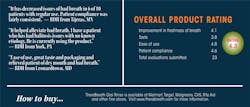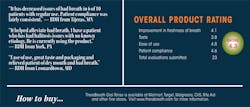Educating patients about the biofilm phenotype
Atlanta's icy experiences last winter made the national news, and it wasn't exactly my best workweek. I commute to work; even my instincts told me to stay home on that day. By 10 a.m., I could see from my operatory that the snow was accumulating rapidly. The roads were turning to ice in the low temperatures, and it quickly became a "perfect storm."
When it snows in Atlanta, everyone panics because we're not prepared with snow plows and salt as in other cities. Our patients began cancelling left and right, and I left the office around noon. It took me 90 minutes to travel about three miles to the expressway ramp and then I drove six miles on the expressway in another four hours. I ended up spending the night in a hotel with a total stranger, with not even a toothbrush in my possession.
Every week in clinical hygiene is different, and this week was no exception. It was full of patient drama. Sometimes the drama is on my end (like an unexpected snowstorm), or it may involve another staff member.
But there are various patient scenarios that make my workday more interesting. Here's one example. An adult female patient, age 45, presented for recare, and she's usually quiet with minimal needs. She was at low risk for dental caries (no history of dental caries and an absence of risk factors), so we waited about 18 months to update her bitewing radiographs. I took four posterior vertical bitewings, and an area of proximal dental caries showed up on one of the digital films. Risk factors included xerostomia and lack of proximal cleaning.
---------------------------------------------------------------------
Other articles by Slim
- Grading evidence concerning bidirectional diabetes
- Cement-associated peri-implantitis
- Is household bleach an effective biofilm killer
---------------------------------------------------------------------
The patient was so flabbergasted by the news that she started crying. She wouldn't stop talking about it, and it was the perfect storm (opportunity) for me to explain dental plaque as a biofilm and the significance of pH as a means of disrupting microbial homeostasis.
Feeling upset, she insisted on taking an i-phone photo of the radiograph and told me it would be prominently displayed as her iPhone wallpaper as a reminder of her status.
I changed her caries status to "caries active," and we agreed to be proactive in fighting dental caries. I have several images of biofilm that I show to patients, including one of an industrial pig for pipelines that is used for scraping biofilm!
I begin by explaining the origin of the word caries that comes from the Latin term "rotten." Most patients still envision a tooth worm boring a hole in a tooth and licking its lips after ingesting its contents. I then go on to say that what you've visualized in your mind isn't true, and I then talk about a cavity as late-stage biofilm-mediated disease. Most of the emphasis is on maintaining supragingival biofilm at a neutral pH, and we conduct some limited testing as recommended by CariFree.
Biofilm and its role in the initiation and chronicity of gingivitis/periodontitis is a bit harder for patients to grasp. So I've racked my brain to find a way to communicate, and I think I've got it down to a science.
Unlike most practicing hygienists I meet, I disclose a lot of my patients with two-tone disclosing solution. One of my pet peeves in some practices is hearing others talk about "calculus" causing "irritation" of the gums. Practitioners and staff who use this terminology are missing the message about the multifactorial nature of chronic periodontitis and should be corrected, but it's easier said than done, especially if it's your employer!
For centuries, we've focused our attention on bacteria and a lot of theory was driven by Koch's postulates, which focused on microorganisms as being causative agents for disease. In dentistry, we've sampled pockets and placed samples on slides so that we could show patients spirochetes swarming in coordinated packs within a thin film of fluid. The gradual shift of focus from planktonic microorganisms to sessile microbial communities has implications for oral health-care professionals, especially if we view chronic periodontitis as a chronic wound.
Instead of focusing our efforts on killing pathogens, we now have to kill pathogenic biofilms instead.
Killing biofilms isn't that difficult to do if they are supragingival. But as we already know, it's not so easy when they're hidden in a crevice adjacent to tooth roots.
To further complicate matters, consideration of the complexity of genetic and environmental factors (especially dietary and lifestyle factors) must be taken into account because they affect microbes in biofilm and other human anatomical systems as well.
I want to focus again on biofilm, but I truly believe we are performing a disservice to our patients by ignoring general health issues. Dental hygienists are prevention specialists, and we must get back to our roots. When meeting a patient for the first time whose periodontium is a train wreck, we need to take a hard look at the client's overall health history instead of being a mindless cleaning machine with an ultrasonic in one hand and an air polisher in the other. And sometimes, sadly, these less-than-ideal daily regimens are forced upon us.
Teaching patients about biofilm is fun for me, and I've developed a character I use called "Gumbug" for younger patients, and he looks like a bacterium. But I've also given him a cape that symbolizes the polysaccharide slime that he lives in. I use Gumbug in my explanations to patients, knowing that true biofilms in pockets look like long, stringy, kelplike blobs attached to a tooth/root. Here are some of the important points I work hard to convey:
- Gum disease doesn't appear to be an infectious disease that can be spread by kissing.1 This is an important conversation starter!
- A sticky slime coats your teeth and is firmly attached to your teeth and roots, and we call it biofilm.
- Biofilm flourishes in a warm, moist environment, especially near and under the gum line and these are areas of biofilm we suppress daily with toothbrush bristles, floss, etc.
- If bacteria become firmly established in a gated community called biofilm, an ongoing battle is waged between the bad bugs and the body's immune system.
- Biofilm persistence results in chronic inflammation around the tooth socket that eventually destroys the bone that keeps the tooth firmly in place.
I use an American Academy of Periodontology animation (here is the website address: www.perio.org/consumer/types-gum-disease.html#OverlayWrapper%5Bflash%5D/0/) to show patients periodontitis progression, and I discuss an ongoing battle between microorganisms in biofilm and the body's immune system.
Risk stratification is also something I incorporate, just as I do with dental caries, and it is recorded in the patient's chart. I spend time discussing additional risk factors such as smoking and poorly controlled diabetes. Risk factors can cause ecological shifts in biofilm and impair the body's ability to fight back.2
Some of my patients have been diagnosed with refractory/aggressive periodontitis. In these cases (as with moderate/severe cases of chronic periodontitis), I always prefer co-managing these patients with a periodontist. My biggest challenge is getting these patients to accept three- to four-month ongoing supportive periodontal therapy. Ongoing biofilm disruption is a term that works particularly well for me in communicating with clients. Personalizing care for periodontal patients and risk stratification just as we now do with dental caries is key.
My explanations aren't perfect but I work hard to align myself with changes in the research literature, particularly concerning the multifactorial nature of periodontal disease.
LYNNE SLIM, RDH, BSDH, MSDH, is an awardwinning writer who has published extensively in dental/dental hygiene journals. Lynne is the CEO of Perio C Dent, a dental practice management company that specializes in the incorporation of conservative periodontal therapy into the hygiene department of dental practices. Lynne is also the owner and moderator of the periotherapist yahoo group: www.yahoogroups.com/group/periotherapist. Lynne speaks on the topic of conservative periodontal therapy and other dental hygiene-related topics. She can be reached at [email protected] or www.periocdent.com.
References
1. Hujoel P, Zina LG, Cunha-Cruz J, Lopez R. Specific infections and the etiology of destructive periodontal disease: a systematic review.
Eur J Oral Sci 2013; 121: 2–6. © 2012 Eur J Oral Sci.
2. Bjarnsholt T. The role of bacterial biofilms in chronic infections. APMIS Suppl. 2013 May; (136):1-51.
Past RDH Issues

